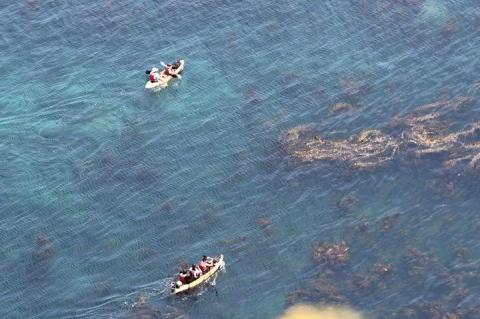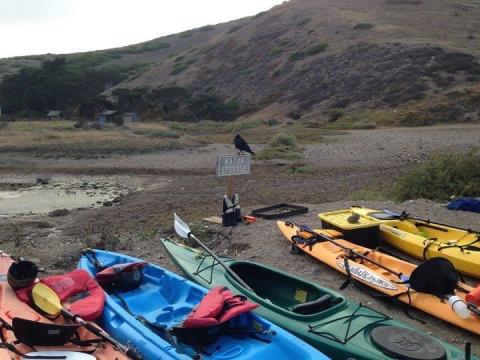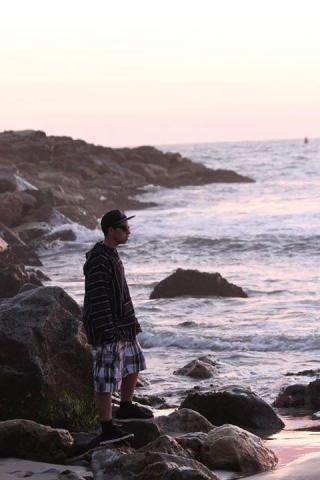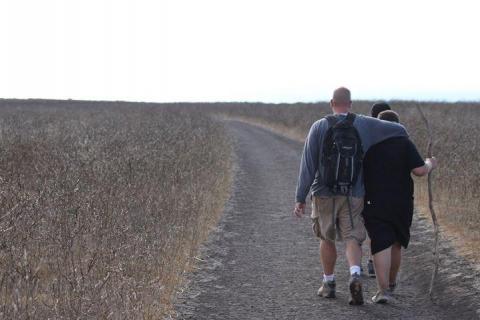




Diego caught a whiff of sweet Eucalyptus-infused California air on his way down to the boat launch. The smell was comforting, but foreign to the Connecticut native – his first time leaving the Greater Hartford Area. The 15-year-old had to run up to the camp to grab his disposable camera he left in his tent. The group would be kayaking around Santa Cruz Island, dipping in and out of the largest collection of sea caves in the world. The experience would be unlike anything Diego had ever done before.
Diego’s involvement in the Youth Excellence Project marks a major shift in his life. With early and chronic exposure to violence and involvement with child protective services, Diego’s outlook on life had been grim. His behavior reflected this – having been suspended from school numerous times because of conflicts with teachers and peers, failing academic subjects, and struggling in his foster care placement.
Diego, like the several other youth in the program, grew up in a home with terrible violence. On an ordinary day, Diego would witness his father tell his mother that she would be “smacked up,” “put in her place,” and even “killed,” that child protective services would “take the kids away,” and that he would leave her with “nothing and no one.” Diego would also serve as the target for his father’s aggression, accumulating bruises upon bruises and undergoing unusual punishment for “not listening.” Diego would try to stop the violence against his mother, only to be punished for it. Diego would watch his mother succumb to drugs and alcohol. She couldn’t be there for him. Mainly, Diego was hungry, scared, unloved, and basically on his own.
Youth like Diego often experience violence and adversity as soon as they come into this world. The violence is severe, chronic, and pervasive – at home, in the community, at school, leaving no option for respite. Other forms of adversity co-occur, like poverty, discrimination, health disparity, neglect, and housing instability. These forms of violence and adversity cumulate to exponentially elevate risk for developing long lasting emotional and behavioral problems and impairment. Depression, anxiety, posttraumatic stress disorder, suicide, academic failure, disruptive behavior, justice-involvement, aggression, alcohol and drug abuse, medical problems – these are all several times more likely in poly-victimized, foster care youth than their peers. They are also highly likely to be re-victimized in the future and to victimize others. These youth also lack the personal and social resources necessary to cope with life stress, establish healthy relationships, and ultimately to make positive contributions to society.
Given the circumstances that result in foster care, most foster care youth are poly-victims, on average, having experienced more than five types of significant trauma. Consequently, they face terrible odds, with deleterious trajectories. Yet, buried in the muck of the experiences they endured are pieces of resilience – strengths that if nurtured could help them to overcome these tremendous challenges. Often, they cannot do it alone. They need help finding these pieces and putting them together. Indeed, social support is one of the strongest predictors of resilient outcomes following trauma and adversity that researchers have been able to measure. Just one meaningful and long-lasting relationship can make all the difference in the world.
However, these trauma-exposed youth have been betrayed and victimized by their primary caregivers, exposed to chronic abuse and neglect, moved from placement to placement and from school to school, and denied the opportunity to develop normative, stable and permanent relationships. In contrast, a normative childhood involves at least one nurturing caregiver with whom a child can feel secure while establishing his social network and forming meaningful relationships with peers, teachers, coaches, and mentors. A nurtured child enters adolescence and into young adulthood having formed a solid foundation of support – a caregiver to call when he has a health concern or to rely on when he has to buy groceries for himself for the first time. This is not the case for many adolescents in child welfare. These youth have often relied on paid staff to provide for them. When they age out of the child welfare system, they are the rare fortunate ones who have someone real and permanent to rely on. The deprivation of social supports throughout their lives is directly linked to their tendency to have low self-confidence and self-efficacy, and a lack of basic skills, coping strategies, and ability to self-regulate under stressful situations.
What can we do to change this reality? This is the question that I asked before initiating the Youth Excellence Project. I am an academic researcher who studies childhood trauma and its consequences and a clinical psychologist who focuses on treating trauma-related psychological problems. I have worked extensively in child welfare and also served many years, along with my wife, as a foster parent and youth mentor. I envisioned a program that would help to facilitate meaningful and long-lasting relationships with positive adults and peers. Thus, that is the primary goal of the Youth Excellence Project. Other objectives are to adopt healthy core values (i.e., commitment, integrity, respect, tolerance, mindfulness, optimism, vision, leadership, social justice, human connection), learn about the impact of stress and trauma and how to cope, build confidence and self-efficacy, experience success, and to develop a life strategy and connect to community resources. These are achieved by way of didactic and experiential learning opportunities.
At first, Diego was hesitant about the program. Was it just another life skills training or group therapy program? He determined it was not. After his first year, he became a youth leader in the program, engaging the new cohort of youth and encouraging them to meet the objectives of the program. Diego developed close relationships with the adult mentors and leaned on them for instrumental and emotional support. While functioning as a youth leader Diego transitioned back to live with his biological mother. Although he lost the state resources available to him as a foster care youth, his relationships and involvement in the Youth Excellence Project were sustained. This provided him a level of support that would otherwise not have been available to him. After all, it is how relationships are supposed to happen in life. Relationships shouldn’t end when the funding ends or when a living situation changes – not when they are so crucial to youth with little else to hold onto.
How can these youth experience making a difference in society? This was another question I asked myself. The answer came readily. These youth have all experienced chronic violence, trauma, and adversity. Many have felt crushed by these memories, unable to take control of them. Instead, many have tried to avoid them, hide them, and get rid of them – with no avail. Traumatic memories are fragmented, powerful, and intrusive; but they can be harnessed with the right work. That is precisely what trauma-focused therapy does – it helps individuals to confront trauma memories, organize them, take control of them, draw meaning from them, and ultimately to incapacitate them. Some individuals even learn and grow from them, build stronger resources, and put their experiences to good use. I imagined this possibility for the youth in my program. Therefore, a final objective of the program is to train youth to become youth ambassadors against violence and to use their own experiences with violence to educate others and to help victims. In doing so, these youth also help themselves to overcome trauma and to take hold of that silver lining in the sky.
Diego was the first youth to take on the task. He developed a public education poster targeting maternal victims of domestic violence with the goal of encouraging them to get help for themselves and for their children. Because he incorporates his personal experiences with family violence into the message it is quite powerful. It reads:
I am a kid who grew up in a violent home with… yelling, screaming, name-calling, constant threats, hitting, kicking, pushing, destroyed property, humiliation, fear, sadness, anger, use of weapons, no love, no safety.
It’s called DOMESTIC VIOLENCE. It affected my life. It can affect your kids too. Kids exposed to domestic violence can… struggle in school, get anxiety or depression, have anger or behavior problems, struggle with trust and relationships, face serious danger, feel bad about themselves, have alcohol and drug problems, miss out on a meaningful relationship with YOU.
There are more kids out there like me. GET HELP. Do it for you and your kids.
By a kid who has lived it.
The poster hangs in two large hospitals in Connecticut and in several other public places. As a group, the youth are also involved in other activities aimed at raising awareness of and preventing violence. Some of the youth helped to facilitate workshops for middle school students on bullying prevention. Other youth are working on a project to raise awareness of dating violence. All youth are encouraged to practice and encourage non-violence in their homes, schools, and communities.
Looking back, there are several stories of personal success I can tell about the youth in the program. One youth with several previous foster care placements, a history of significant behavior problems, and weight-related health problems, which limited his physical activity, showed substantial growth. This youth developed self-confidence and a willingness and motivation to participate in challenging activities that I would not have predicted. At the end of the Channel Islands trip this youth had recorded more mileage from hiking than any other youth in the program. Further, behavior issues at home and in school markedly diminished. This year he is the rising star in the program. His leadership skills are truly impressive. He engages the new cohort of youth in learning about violence and its consequences and he is the first to redirect youth whose behavior or language violates one of our core values.
Another example is best shared via an email that one of the child protective services caseworkers sent me earlier this year. In it he wrote:
I am so happy that David has jumped on this opportunity. If you only knew what he and his siblings went through in the biological home…his resilience amazes me. All of the people working with David have reported that his involvement in the program was life changing for him and that he is a totally different kid. After the California trip last summer, he was able to (finally) sit one-on-one with me to tell me about the abuse in his biological home. For that, I am very grateful.
Just last month, during one of our campouts, one of the youth from the new cohort shared with the group his experiences of physical abuse and the challenges he currently faces because of it. Many of the kids look up to Kyle because of his athletic abilities and natural leadership skills. Kyle went on to explain to the others that he recently started trauma-focused therapy to work on his some of his problems related to the abuse. He shared that while he is nervous, he is hopeful that the therapy will make a difference for him and willing to give it a shot. I believe that Kyle’s sharing his experiences and involvement in therapy is monumental in terms of de-stigmatizing psychological treatment and motivating his peers to consider engaging in this work. Following Kyle’s explanation, several other youths spoke up about their experiences. It truly was a moment to applaud the work we are doing with these youth.
In several weeks we will be traveling to California to spend a weeklong retreat in the Channel Islands National Park. Guided by Channel Islands Outfitters, we will be snorkeling in kelp forests, kayaking in and out of remarkable caves, hiking on gorgeous bluffs looking over the Pacific, and once again smelling that sweet scent of eucalyptus. In addition to these adventures, we will be working together to meet personal and group objectives and to devise new ideas for getting the word out about violence prevention and intervention.
The Youth Excellence Project is entirely directed and run by volunteers. Several funding sources make the Youth Excellence Project possible. LISA, Inc. sponsors the program. Other support comes from the J. W. Bissell Foundation, the Fund for Greater Hartford, the Floor Charitable Trust, the Fisher Foundation, and several donations from individuals and businesses, including Garrett’s Barber Shop, Pete’s Waste Removal, Cornerstone Construction, and others.
If you wish to make a donation to the program you are encouraged to do so on our GoFundMe account (http://www.gofundme.com/tdza2a28) or send a check or money order made out to LISA, Inc. (P.O. Box 6232, Wolcott, CT 06716-0232) with ‘YEP’ in the memo. To learn more about the program or to stay abreast of our activities, visit our website at www.ctyouthexcellenceproject.com or contact the program director, Dr. Damion Grasso, by email (dgrasso@uchc.edu).

 Owner/Editor - Chris Chmielewski
Owner/Editor - Chris Chmielewski